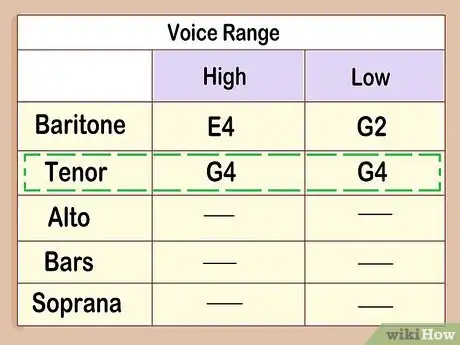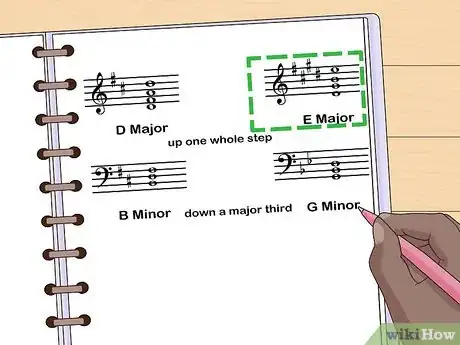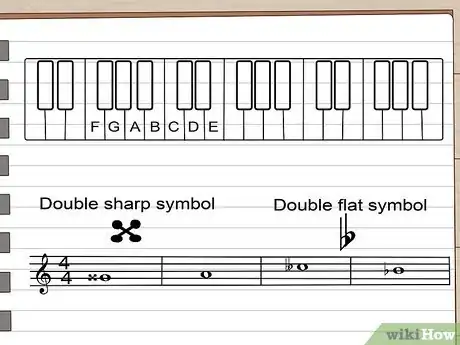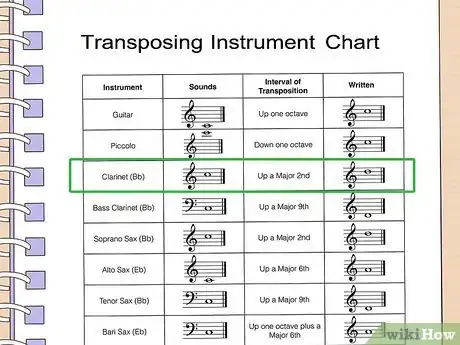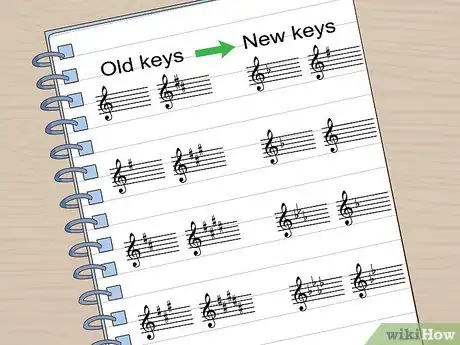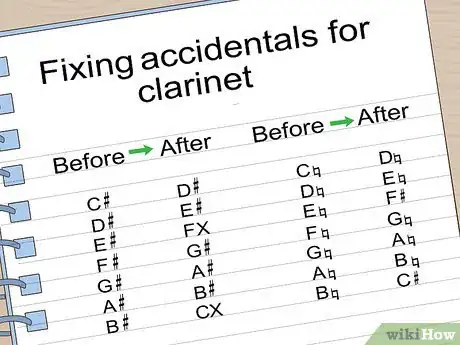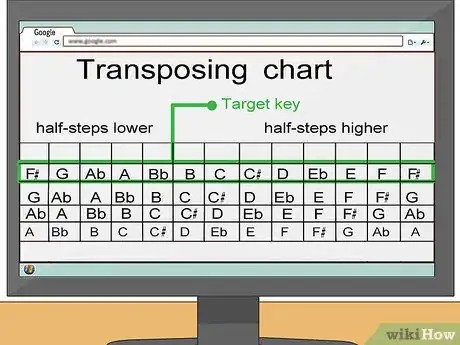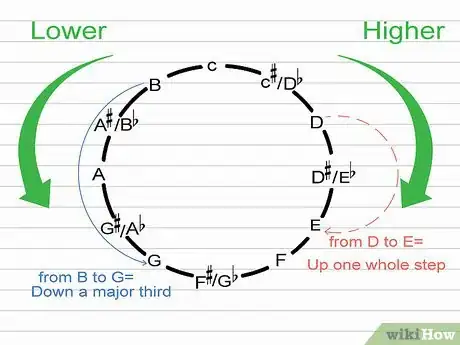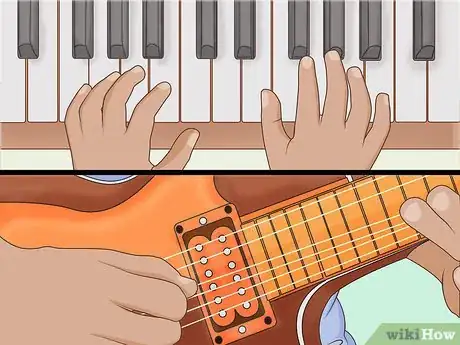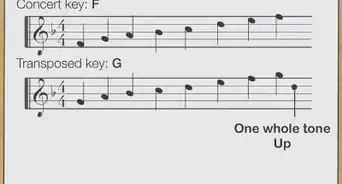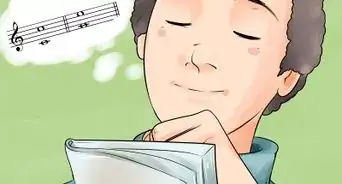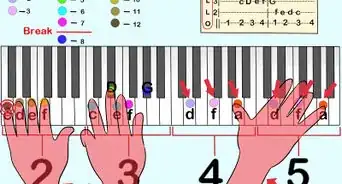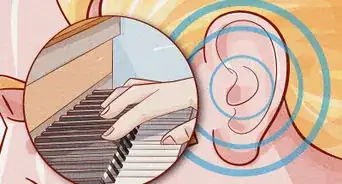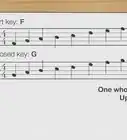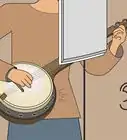X
This article was co-authored by wikiHow staff writer, Jennifer Mueller, JD. Jennifer Mueller is a wikiHow Content Creator. She specializes in reviewing, fact-checking, and evaluating wikiHow's content to ensure thoroughness and accuracy. Jennifer holds a JD from Indiana University Maurer School of Law in 2006.
This article has been viewed 144,222 times.
Learn more...
You might need to change musical keys on a piano to accommodate a particular vocalist or instrument – a process known as transposing a song. You can transpose using sheet music or by ear. If you're using chords, you also can transpose chords without necessarily needing to know how to read music.[1]
Steps
Method 1
Method 1 of 3:
Transposing Music for Vocalists
-
1Identify the vocalist's range. A vocalist's range consists of all the notes between the highest and lowest notes they can sing. Within that overall range, they may have specific areas or keys where they are most comfortable singing.[2]
- Your vocalist should be able to provide this information to you. If they're unsure, you might have to rely on trial and error to find the best transposition.
-
2Find your interval. Find the highest or lowest note, whichever is giving the vocalist difficulty. Adjust the note up or down until it falls within your vocalist's range. Then count the number of steps or half-steps between the original note and the new note.[3]
- If you have both high and low notes that are outside your vocalist's range, you may have to transpose the song into two different keys to make it work.
Advertisement -
3Write your new key signature. The key in which the song is played will be transposed just as the notes are. If you are transposing into a particular key, you'll already know what key it's in. If you're just moving up a step or two, you'll need to work it out.[4]
- If you're unsure about the key, you can use a chromatic circle to find the relation between the keys. These are readily available online. Move counter-clockwise around the circle if you're moving the notes up, and clockwise if you're moving the notes down.
- For example, if you started in D Major and went up one whole step, your transposed song is in E Major.
-
4Move the notes into the new key. To transpose the song, you must move each note up the same interval. If the song has other sharps and flats not related to the original key signature, ignore it for now – but mark where it is.[5]
- Transpose a note with an accidental sharp or flat from where it normally would be in the original key. For example, assume the B note is natural in the original key. If the song has an accidental B-flat, you would move the note from B – not from B-flat.
-
5Adjust the accidentals. Once you've transposed the entire song, go back to the original score and look for any sharps or flats. Work out how far up or down the original accidental moved the note, and then adjust it that number of steps in your transposed song.[6]
- For example, assume the B note is natural in the original key. If the song has an accidental B-sharp, that means the natural B was moved up a half-step.
- Find that note in your transposed song and move the transposed note up a half-step as well, marking the new accidental.
-
6Play the transposed song. After you've completed your transposition, it's a good idea to play through the song and check to make sure you've moved the notes correctly. Your vocalist also may want to try the song out and see if it's now more comfortable for them to sing.[7]
Advertisement
Method 2
Method 2 of 3:
Transposing Music for Instruments
-
1Determine the reason to transpose the music. If you're simply transposing the music to make it easier for the musician to play on their instrument, the transposition process is the same as if you were transposing the music for a vocalist.[8]
- Some songs are easier to play on some instruments in one key than in another. Beginner musicians often can play more complex songs if they are transposed to an easier key.
- If you are playing with a musician who plays a "transposing instrument," however, the process is a little bit different. Transposing instruments are those such as the clarinet, for which a C would sound like a B-flat when played.
-
2Identify the instrument's key. If you're transposing a song for a transposing instrument, the key of the instrument will tell you how many steps up or down you need to transpose the song. Your interval is the number of steps between the original key of the song and the key of the transposing instrument.[9]
- For example, if you have a song written in C that you need to transpose for a B-flat clarinet, you would need to move all the notes up a whole step, since B-flat is a whole step down from C.
- You also can use a transposition chart, that will tell you exactly what transposition you need if you want the song to sound right on transposing instruments.[10]
-
3Move the notes up or down. Now that you know the interval you need, all the notes in the song must be moved the same interval. Mark any sharps or flats not part of the key signature so you can come back to them.[11]
- Move accidentals up or down from the same tone the note would have had in the original key signature. For example, if the song has a C-sharp and C is normally natural in that song's original key, you want to transpose from natural C.
-
4Find the new key for the song. With all the notes moved and no accidentals, you should be able to work out what key the song is now in. If you're not strong on your keys yet, there are charts available online that will tell you.[12]
- If you're working on sheet music, you'll want to note your key signature at the beginning of the song.
-
5Fix your accidentals. Now that the entire song is transposed in the new key, you'll need to also move up any sharps or flats that appeared in the song and weren't part of the key signature.[13]
- Go back to the original song and find the accidentals. Work out how far the accidental moved the note from where it normally would be in the original key signature.
- For example, if your song has a C-sharp and C is normally natural in that song's original key, the accidental has moved the note a half-step. Find that note on your transposed song and move it up a half-step as well, marking the accidental accordingly.
-
6Listen to the song played on the transposing instrument. If you've transposed the song correctly, when it is played on the transposing instrument it will sound exactly the same as when it is played on a different instrument.[14]
Advertisement
Method 3
Method 3 of 3:
Transposing Chords
-
1Find your target key. You can transpose chords to a song without necessarily being able to read sheet music. This method is ideal if you want to make a song easier to play on another instrument, such as a guitar.
- This method also works if you want to move a song up or down to better accommodate a vocalist.
-
2Figure out the interval. Look at the original key the song is in. The number of half-steps between the original key and the key you want the song to be in is your interval. You'll need to move all of the chords in the song that same interval up or down.[15]
- For example, if your original song is in C and you want to transpose it to E, you'll need to move every chord in the song up four half-steps.
-
3Use a chromatic circle. The chromatic circle shows the relationship between all the chords. Move along the circle the appropriate number of half-steps clockwise if you're moving the chords up, or counter-clockwise if you're moving the chords down.[16]
- You also could use a transposition table, which tells you exactly what chords to use. You may be able to get one at a music store, or you can search for one online.
-
4Play the transposed song. Once you've finished moving all the chords up or down to transpose the song, play it through once on your piano. If you're ultimately going to play the song on a guitar or another instrument, you may want to play it through on that instrument as well to make sure it sounds okay.[17]
- Even though it will be in a different key, the song should sound essentially the same. If anything sounds off, you may have transposed a chord incorrectly.
Advertisement
Community Q&A
-
QuestionI want to play a piece of music on my digital piano with another musician who plays Bb Clarinet. If I lower the piano by two semi-tones, will it sound the same as the Bb clarinet?
 Community AnswerNo. A B-flat clarinet doesn't just play in the key of B-flat; it is up to the musician to play in the specified key. For example, if the key is F, she and you would both play using notes from the F scale.
Community AnswerNo. A B-flat clarinet doesn't just play in the key of B-flat; it is up to the musician to play in the specified key. For example, if the key is F, she and you would both play using notes from the F scale. -
QuestionHow do I transpose a classical piece from C major to E major?
 Community AnswerPretend these are the notes in the piece: C E G F C B C. This follows the key of C major, which is no sharps and no flats. The key of E major has four sharps: F#, C#, G#, and D#. Because C is the first note of the C major scale, your new transposed piece will begin on the first note of the E major scale, which is E. To transpose the rest of the piece, follow this pattern: E is the third note of the C major scale, and the third note of the E major scale is G# -- therefore, G# is your next note. G is the fifth note of the C major scale, and the fifth note of the E major scale is B, and so on.
Community AnswerPretend these are the notes in the piece: C E G F C B C. This follows the key of C major, which is no sharps and no flats. The key of E major has four sharps: F#, C#, G#, and D#. Because C is the first note of the C major scale, your new transposed piece will begin on the first note of the E major scale, which is E. To transpose the rest of the piece, follow this pattern: E is the third note of the C major scale, and the third note of the E major scale is G# -- therefore, G# is your next note. G is the fifth note of the C major scale, and the fifth note of the E major scale is B, and so on. -
QuestionI have a song written in six flats. Is there a way to keep that key but write it down in sharps instead?
 Community AnswerSix flats is G-flat major or E-flat minor, which is F-sharp major or D-sharp minor.
Community AnswerSix flats is G-flat major or E-flat minor, which is F-sharp major or D-sharp minor.
Advertisement
References
- ↑ https://www.earmaster.com/music-theory-online/ch06/chapter-6-4.html
- ↑ https://www.earmaster.com/music-theory-online/ch02/chapter-2-7.html#m12381
- ↑ https://www.earmaster.com/music-theory-online/ch06/chapter-6-4.html
- ↑ https://www.earmaster.com/music-theory-online/ch06/chapter-6-4.html
- ↑ https://www.earmaster.com/music-theory-online/ch06/chapter-6-4.html
- ↑ https://www.flutetunes.com/articles/transpose-b-flat/
- ↑ https://www.earmaster.com/music-theory-online/ch06/chapter-6-4.html
- ↑ https://www.earmaster.com/music-theory-online/ch06/chapter-6-4.html
- ↑ https://www.flutetunes.com/articles/transpose-b-flat/
- ↑ http://www.musicnotes.com/blog/2014/08/08/how-to-transpose-music/
- ↑ http://www.musicnotes.com/blog/2014/08/08/how-to-transpose-music/
- ↑ https://www.flutetunes.com/articles/transpose-b-flat/
- ↑ https://www.flutetunes.com/articles/transpose-b-flat/
- ↑ https://www.flutetunes.com/articles/transpose-b-flat/
- ↑ http://www.transposechords.com/how-to-transpose-chords
- ↑ https://www.earmaster.com/music-theory-online/ch06/chapter-6-4.html
- ↑ https://www.earmaster.com/music-theory-online/ch06/chapter-6-4.html
About This Article
Advertisement
